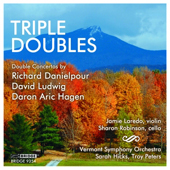
COLLECTIONS

Everyone knows the Brahms Double Concerto for violin, cello and
orchestra. It displays not only the composer's genius, but the great
potential for this combination of instruments. All things considered,
it's surprising that concertos of this sort haven't taken off with
composers. Until this collection arrived, I knew of only one other
example, the Delius 1916 Double Concerto. Here we have three of them, all
written in the last ten years or so, and all written for violinist Jaime
Laredo and his cellist wife, Sharon Robinson. Laredo, best known as a
violinist, is also the music director of the Vermont Symphony Orchestra,
though he passes on the conducting to two younger musicians for these
recordings.
Richard Danielpour is a composer of wide renown in the United States.
His work has been unfamiliar to me until now, unfortunately. His 1999 A
Child's Reliquary was originally a piano trio but became a concerto when
the composer orchestrated the piano part in 2006. It was written as a
meditation on the short life and early death of Cole Carson St. Clair,
the son of an American conductor, who drowned at the age of 18 months.
Loosely constructed from some variations "around" the Brahms Wiegenslied
(Cradle Song). It is a moving piece that rewards repeated hearings
handsomely.
The Greeks of Antiquity recognized three kinds of love: Eros, Agape and
Philia. Each of these is the inspiration for one of the movements of
David Ludwig's Concerto for Violin, Cello and Orchestra. Eros, the first
movement, comes across as thundering lust, though there is a middle
section with some suggestion of tenderness. Ludwig represents Agape as
an evocation of unconsummated love, something like that of Tristan and
Isolde. In this movement the soloists never play together until near the
end. The effect is striking. The third movement, Philia, is a response to the teachings of Buddha,
intended to sound celebratory, and for the most part it succeeds.
Between the movements of this concerto there are what the composer calls
interludes. They're short, serving to mediate the contrasting moods of
the music before and after them. Another very fine piece.
If Daron Aric Hagen's Masquerade seems slighter at first than the other
concertos, it's probably because it reflects something of the
Commedia dell'arte tradition. In the sense that it represents a fairly
specific story it is more programmatic than its disc mates.
So how are the performances? The word that first comes to mind is
"magisterial." Laredo and Robinson play the music as though they own it
which, in a sense, they do. As for the Vermont Symphony, it doubtless
has its limitations, but they are not readily apparent in these
recordings. Laredo and Robinson have also recorded double concertos written for
them by Ellen Taaffe Zwilich and Ned Rorem on Koch International
Classics.
Richard Todd - May 2012